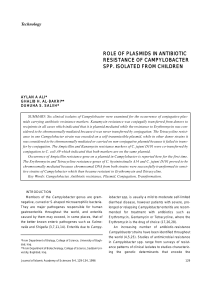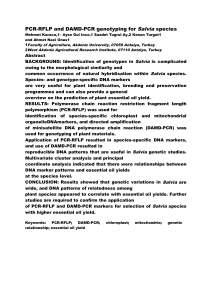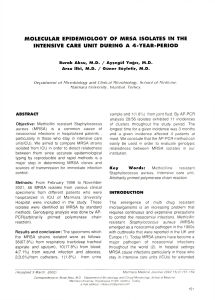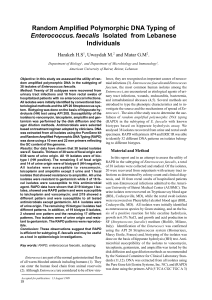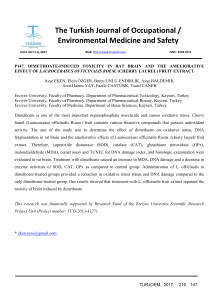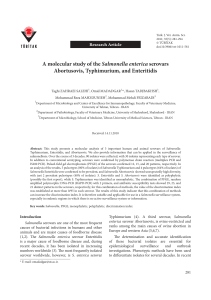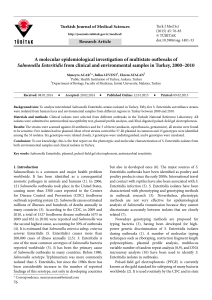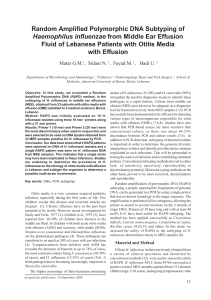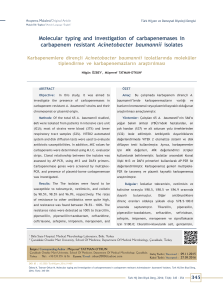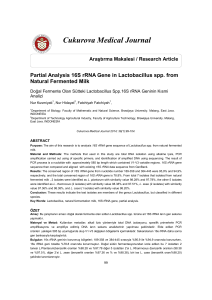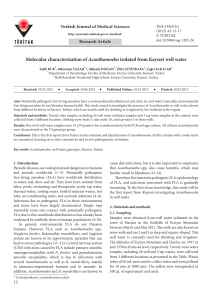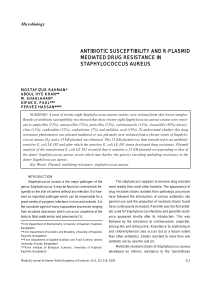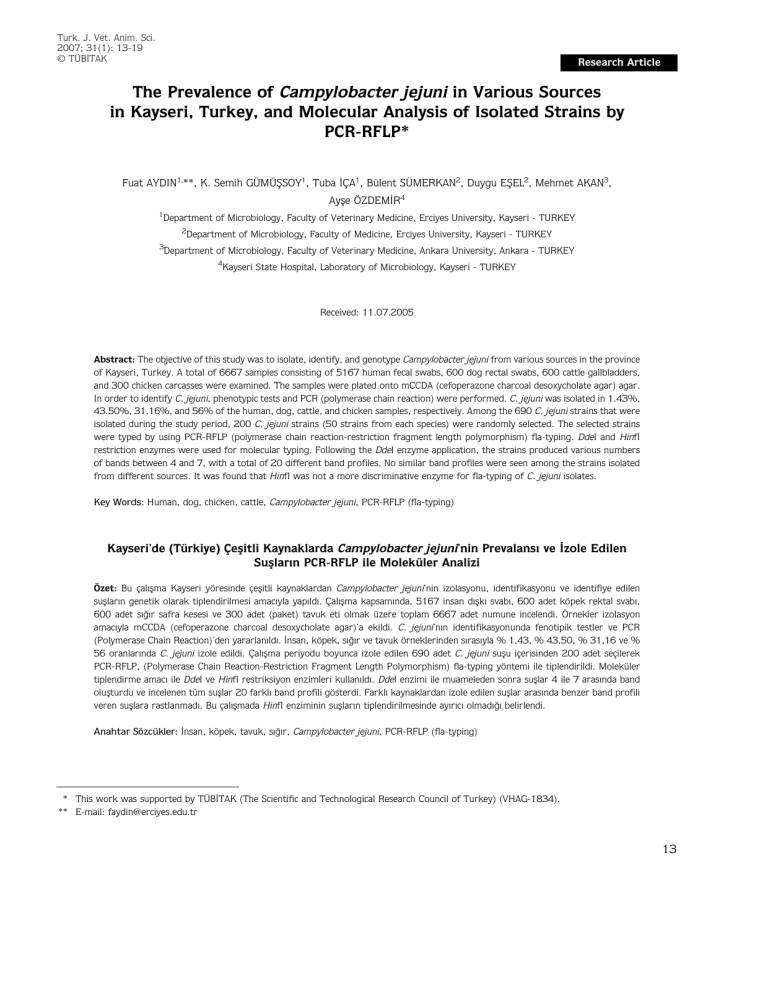
Turk. J. Vet. Anim. Sci.
2007; 31(1): 13-19
© TÜB‹TAK
Research Article
The Prevalence of Campylobacter jejuni in Various Sources
in Kayseri, Turkey, and Molecular Analysis of Isolated Strains by
PCR-RFLP*
Fuat AYDIN1,**, K. Semih GÜMÜfiSOY1, Tuba ‹ÇA1, Bülent SÜMERKAN2, Duygu EfiEL2, Mehmet AKAN3,
Ayfle ÖZDEM‹R4
1
Department of Microbiology, Faculty of Veterinary Medicine, Erciyes University, Kayseri - TURKEY
2
Department of Microbiology, Faculty of Medicine, Erciyes University, Kayseri - TURKEY
3
Department of Microbiology, Faculty of Veterinary Medicine, Ankara University, Ankara - TURKEY
4
Kayseri State Hospital, Laboratory of Microbiology, Kayseri - TURKEY
Received: 11.07.2005
Abstract: The objective of this study was to isolate, identify, and genotype Campylobacter jejuni from various sources in the province
of Kayseri, Turkey. A total of 6667 samples consisting of 5167 human fecal swabs, 600 dog rectal swabs, 600 cattle gallbladders,
and 300 chicken carcasses were examined. The samples were plated onto mCCDA (cefoperazone charcoal desoxycholate agar) agar.
In order to identify C. jejuni, phenotypic tests and PCR (polymerase chain reaction) were performed. C. jejuni was isolated in 1.43%,
43.50%, 31.16%, and 56% of the human, dog, cattle, and chicken samples, respectively. Among the 690 C. jejuni strains that were
isolated during the study period, 200 C. jejuni strains (50 strains from each species) were randomly selected. The selected strains
were typed by using PCR-RFLP (polymerase chain reaction-restriction fragment length polymorphism) fla-typing. DdeI and HinfI
restriction enzymes were used for molecular typing. Following the DdeI enzyme application, the strains produced various numbers
of bands between 4 and 7, with a total of 20 different band profiles. No similar band profiles were seen among the strains isolated
from different sources. It was found that HinfI was not a more discriminative enzyme for fla-typing of C. jejuni isolates.
Key Words: Human, dog, chicken, cattle, Campylobacter jejuni, PCR-RFLP (fla-typing)
Kayseri’de (Türkiye) Çeflitli Kaynaklarda Campylobacter jejuni’nin Prevalans› ve ‹zole Edilen
Sufllar›n PCR-RFLP ile Moleküler Analizi
Özet: Bu çal›flma Kayseri yöresinde çeflitli kaynaklardan Campylobacter jejuni’nin izolasyonu, identifikasyonu ve identifiye edilen
sufllar›n genetik olarak tiplendirilmesi amac›yla yap›ld›. Çal›flma kapsam›nda, 5167 insan d›flk› svab›, 600 adet köpek rektal svab›,
600 adet s›¤›r safra kesesi ve 300 adet (paket) tavuk eti olmak üzere toplam 6667 adet numune incelendi. Örnekler izolasyon
amac›yla mCCDA (cefoperazone charcoal desoxycholate agar)’a ekildi. C. jejuni’n›n identifikasyonunda fenotipik testler ve PCR
(Polymerase Chain Reaction)’den yararlan›ld›. ‹nsan, köpek, s›¤›r ve tavuk örneklerinden s›ras›yla % 1,43, % 43,50, % 31,16 ve %
56 oranlar›nda C. jejuni izole edildi. Çal›flma periyodu boyunca izole edilen 690 adet C. jejuni suflu içerisinden 200 adet seçilerek
PCR-RFLP, (Polymerase Chain Reaction-Restriction Fragment Length Polymorphism) fla-typing yöntemi ile tiplendirildi. Moleküler
tiplendirme amac› ile DdeI ve HinfI restriksiyon enzimleri kullan›ld›. DdeI enzimi ile muameleden sonra sufllar 4 ile 7 aras›nda band
oluflturdu ve incelenen tüm sufllar 20 farkl› band profili gösterdi. Farkl› kaynaklardan izole edilen sufllar aras›nda benzer band profili
veren sufllara rastlanmad›. Bu çal›flmada HinfI enziminin sufllar›n tiplendirilmesinde ay›r›c› olmad›¤› belirlendi.
Anahtar Sözcükler: ‹nsan, köpek, tavuk, s›¤›r, Campylobacter jejuni, PCR-RFLP (fla-typing)
* This work was supported by TÜB‹TAK (The Scientific and Technological Research Council of Turkey) (VHAG-1834).
** E-mail: [email protected]
13
The Prevalence of Campylobacter jejuni in Various Sources in Kayseri, Turkey, and Molecular Analysis of Isolated Strains by PCR-RFLP
Introduction
Campylobacter is commonly found in the
gastrointestinal tracts of domestic and wild animals and
is commensal (1,2). Many strains, however, particularly
Campylobacter jejuni (C. jejuni), are enteric human
pathogens. It is widely assumed that campylobacteriosis
is primarily a food-borne disease. Contaminated meat,
milk, and water are thought to be the major sources of
human infection. Domestic pets, wild birds, and wild
animals are also potential sources of C. jejuni infection
in humans. Transmission occurs through the
consumption of contaminated water and animal
products (e.g., meat and milk), direct contact with
infected animals, or handling undercooked poultry (3).
Several strain typing methods (e.g., phenotyping
and genotyping) have been developed to understand
the epidemiology of and to identify the transmission
routes of C. jejuni, particularly in regard to humans.
Although various phenotyping methods have been
described, such as serotyping, biotyping, and phagetyping, these methods require specialist skills and a
reagent, and are time consuming. It is also difficult to
standardize these methods globally (4). Recently,
several new genotyping techniques have been
developed, including ribotyping, pulsed-field gel
electrophoresis (PFGE), polymerase chain reactionrestriction fragment length polymorphism (PCR-RFLP),
flagellin typing (fla-typing), random amplified
polymorphic DNA (RAPD), and amplified fragment
length polymorphism (AFLP) (4,5).
The flagellin gene locus of C. jejuni contains 2
flagellin genes (flaA and flaB). This locus is suitable for
PCR-RFLP analysis of PCR products because both
genes are highly conserved, and variable regions are
present. Thus, it has been reported that the use of a
primer specifically designed for the amplification of fla
in PCR-RFLP (fla-typing) is a useful, reliable, simple,
and valuable subtyping technique for epidemiological
studies (4).
The current study was undertaken to determine the
prevalence of C. jejuni in various sources in Kayseri,
Turkey. A secondary objective was the detection of C.
jejuni subtypes using PCR-RFLP (fla-typing).
14
Materials and Methods
Bacterial strains
Between September 2002 and August 2003, 619 C.
jejuni strains were recovered from different sources. The
origin and number of these isolates are presented in Table
1. Human samples were taken from diarrheic patients.
The dog and cattle samples were obtained from healthy
animals. C. jejuni NCTC 11168 was used as the reference
strain.
Isolation of enteric campylobacters
Modified CCDA (mCCDA) (LAB M lab 112) and a
selective supplement (LAB M, cefoperazone-amphotericin,
X112) were used for primary isolation of enteric
campylobacters. Incubation was performed under microaerobic conditions for 24 to 48 h at 37 °C. All strains
were identified using classical methods (2,6).
Identification of C. jejuni
A. Phenotyping assay
C. jejuni was identified by observing characteristic
morphology and motility using phase contrast microscopy
and also by using a phenotyping assay, which included
growth patterns at various temperatures (25 °C and 42
°C), catalase production, oxidase reaction, hippurate
hydrolysis, H2S production, and susceptibility to nalidixic
acid and cephalothin (2,7).
B. Identification of C. jejuni by PCR
CeuE gene-specific primers (JEJ1 5’-CCT GCT ACG
GTG AAA GTT TTG C-3’ and JEJ2 5’-GAT CTT TTT GTT
TTG TGC TGC-3’) were used for identification of C. jejuni
(8).
Polymerase Chain Reaction-Restriction Fragment
Length Polymorphism (PCR-RFLP), (fla-typing)
Among the 690 C. jejuni strains that were isolated
during a 1-year period, 200 C. jejuni strains (50 human,
50 chicken, 50 cattle, and 50 dog) were randomly
selected. They were genotyped by a slightly modified
PCR-RFLP fla-typing method, which is described
elsewhere (9).
Bacterial DNA was prepared using a commercial DNA
isolation kit (Genomic DNA Purification Kit, Fermentas,
Lithuania). DNA concentrations were measured using a
spectrophotometer (A260) and diluted with sterile water
to approximately 20 ng/µl.
F. AYDIN, K. S. GÜMÜfiSOY, T. ‹ÇA, B. SÜMERKAN, D. EfiEL, M. AKAN, A. ÖZDEM‹R
FlaA genes (approximately 1700 bp) were amplified
with specific primers (A1: 5'-GGA TTT CGT ATT AAC ACA
AAT GGT GC-3', A2: 5'-CTG TAG TAA TCT TAA AAC ATT
TTG-3') and digested separately using DdeI (Promega,
USA) and HinfI (Fermentas, Lithuania). Amplified and
digested fragments were visualized using a GeneSnapGene Genius Bio Imaging System (Syngene, Cambridge,
UK) and analyzed using Gene Tools software from
Syngene. Genetic similarity among strains was calculated
on a simple matching coefficient (10). The size of
digested fragments on the gel was calculated from
migration distances using UPGMA (unweighted pair
group method with arithmetic mean) algorithms (11).
M
1
2
3
4
5
6
7
1700 bp
1000 bp
500 bp
200 bp
Figure 1. PCR amplification product of the C. jejuni flaA gene
(approximately 1700 bp). M: 100 bp DNA ladder, Gene
RulerTM; 1: Positive control; 2: Negative control; 3: Human
C. jejuni isolate; 4: Dog C. jejuni isolate; 5: Cattle C. jejuni
isolate; 6 and 7: Chicken C. jejuni isolate.
Results
DdeI restriction
Isolation of enteric
identification of C. jejuni
campylobacters
and
The number of enteric campylobacters and the
isolation rates of C. jejuni are given in Table 1. All
presumptive C. jejuni strains identified with phenotyping
methods were found to be positive by PCR; 793 bp
fragments were observed on agarose gel.
PCR-RFLP fla-typing
PCR products amplified with the flaA gene-specific
primer were present in bands of 1700 bp (Figure 1).
After the digestion of the amplicon with DdeI and HinfI,
bands ranging from 100 to 1100 bp were detected.
Analysis of the 200 strains selected randomly from
different isolates resulted in 20 different band profiles
consisting of 4 to 7 bands each, after digestion with DdeI.
The patterns of each band were evaluated as a group. No
relationship among the strains of different origins could
be detected (Table 2).
Fifty human isolates formed 4 different groups; 28
isolates were detected in the first group, 8 in the second
group, and 7 isolates each in the third and fourth groups
(Figure 2). Similarity levels among the groups were
57.14% to 66.67%.
Table 1. Number of enteric campylobacters and isolation rates of C. jejuni recovered from
different sources.
C. jejuni
No.
of
samples
No. of
enteric
campylobacters
No. of positive
samples
Isolation
rate (%)
Humans *
5167
108
74
1.43
Dogs**
600
331
261
43.50
Cattle**
600
272
187
31.16
Chickens
300
230
168
56
TOTAL
6667
941
690
10.34
* Fecal samples were taken from diarrheic patients
** Dog rectal swab samples and cattle gallbladders were taken from healthy animals
15
The Prevalence of Campylobacter jejuni in Various Sources in Kayseri, Turkey, and Molecular Analysis of Isolated Strains by PCR-RFLP
Table 2. Number of band patterns of C. jejuni isolates after DdeI enzyme digestion.
Source of isolates
Numbers of isolates
Humans
Dogs
Cattle
Chickens
Total
M
D1
D2
D2
D3
D4
Band patterns
Similarity level (%)
28
D1
57.14-66.67
8
D2
7
D3
7
D4
7
D5
9
D6
10
D7
11
D8
13
D9
5
D10
9
D11
10
D12
11
D13
15
D14
5
D15
6
D16
7
D17
8
D18
11
D19
13
D20
200
20
D2
R
1000 bp
500 bp
200 bp
Figure 2. RFLP band patterns generated by DdeI digestion of the PCR
product from flaA of human C. jejuni isolates. M: 100 bp
DNA ladder; R: Reference strain (C. jejuni NCTC 11168).
52.63-70
47.06-75
50-77.78
Fifty cattle isolates formed 5 distinct groups; 5
isolates were detected in the first group, 9 in the second,
10 in the third, 11 in the fourth, and 15 in the fifth
(Figure 3). Similarity levels among the groups were
47.06% to 75%.
Fifty poultry isolates formed 6 different groups; 5
isolates were detected in the first group, 6 in the second,
7 in the third, 8 in the fourth, 11 in the fifth, and 13 in
the sixth (Figure 3). Similarity levels among the groups
were 50% to 77.78%.
HinfI restriction
Fifty dog isolates formed 5 different groups; 7
isolates were detected in the first group, 9 in the second,
10 in the third, 11 in the fourth, and 13 in the fifth
(Figure 3). Similarity levels among the groups were
52.63% to 70%.
16
Analysis of the 200 strains resulted in 2 different
banding patterns formed by 2 to 3 bands (Table 3). In all,
190 isolated strains of different origins were detected in
the first group and 10 strains were detected in the
second group (Figure 4). In the first group, 40 human,
F. AYDIN, K. S. GÜMÜfiSOY, T. ‹ÇA, B. SÜMERKAN, D. EfiEL, M. AKAN, A. ÖZDEM‹R
M
D5
D6
D7
D8
D9
D10 D11 D12
D13 D15
D16 D17
D18 D19
1000 bp
500 bp
100 bp
Figure 3. RFLP band patterns generated by DdeI digestion of the PCR product from flaA of C. jejuni isolated from dogs, cattle,
and chickens. M: 100 bp DNA ladder; D5-D9: Dog isolates: D10-D13: Cattle isolates; D15-19: Chicken isolates.
* Patterns D14 and D20, isolates obtained from cattle and chickens, respectively, are not represented in this figure.
Table 3. Number of band patterns of C. jejuni isolates after HinfI enzyme digestion.
Source of isolates
Numbers of isolates
Humans
Band patterns
Similarity level (%)
57.14
40
H1
10
H2
Dogs
50
H1
Cattle
50
H1
Chickens
50
H1
Total
200
2
and all dog, cattle, and chicken strains were detected. The
rest of the human strains were detected in the second
group. The similarity level between the 2 groups was
57.14%.
M
H1
H2
H1
H2
H1
1000 bp
500 bp
200 bp
Figure 4. RFLP patterns generated by HinfI digestion of the PCR
product from flaA of C. jejuni M: 100 bp DNA ladder.
Discussion
Various studies have revealed that campylobacters
present in the intestinal contents of chickens spread to
their carcasses during slaughter, contaminating the
carcasses, thus resulting in a public health risk (12).
Isolation rates of C. jejuni from contaminated carcasses
show variability. The C. jejuni rates found in chicken
carcasses in different countries included 56% by Yıldız
and Diker (13), 54% by Kwiatek et al. (14), 61% by Shih
(15), 41% by Quinones-Ramirez et al. (16), and 50% by
Özer and Ergün (17).
C. jejuni is commensally present in the intestinal flora
of cattle (18,19) and dogs (20,21). In addition to the
above-mentioned chicken carcasses, dogs and cattle also
present a risk factor for human campylobacteriosis. Torre
and Tello (20) isolated C. jejuni from healthy dogs at a
17
The Prevalence of Campylobacter jejuni in Various Sources in Kayseri, Turkey, and Molecular Analysis of Isolated Strains by PCR-RFLP
rate of 14.36% and Sandberg et al. (21) isolated it at a
rate of 3%. Diker and ‹stanbulluo¤lu (22) found C. jejuni
in 62% of healthy cattle and 27% of healthy calves. Diker
(6) found C. jejuni at the rate of 14% in both cattle
gallbladders and stool samples. Çetin et al. (23) found it
in 7% of cattle feces.
In the present investigation, C. jejuni was isolated at a
rate of 56% from chicken carcasses, 31.16% from cattle
gallbladders, and 43.50% from dog rectal swabs. The C.
jejuni rate determined in this study was similar to those
found in previous studies of chicken intestines in Turkey
and other countries; however, the isolation rate of C.
jejuni in dogs and cattle was higher than those found in
other studies. Differences in isolation rates of C. jejuni
may be attributed to several factors, such as sample size,
medium, and isolation and identification procedure.
Compared to other pathogens, campylobacters are
the most frequently isolated agents causing
gastroenteritis in developed countries (3). In Turkey, C.
jejuni isolation rates in humans with enteritis were found
to be 7.5% by Iflık et al. (24), 8.80% by Yıldırım et al.
(25), and 2.25% by Aktafl and Tuncel (26).
In our study, C. jejuni was isolated at the rate of
1.43% in the feces of humans with enteritis. The
isolation rate of C. jejuni in humans was lower in our
study than in other studies performed in other cities.
These differences may be due to variances in consumption
rates and cooking procedures for meat, number of
examined samples, direct contact with domestic animals,
and milk and water hygiene in Kayseri.
Fla-typing methods are applied to understand the
epidemiology of campylobacteriosis, and in particular to
establish sources of outbreaks and transmission routes.
The restriction enzymes used in PCR-RFLP fla-typing
methods, such as AluI, DdeI, HinfI, MboI, EcoRI, and PstI,
are generated from different PCR product fragments and
used in various combinations (4,27).
Lindstedt et al. (28) performed DdeI digestion on 84
C. jejuni strains of different origins and observed 18
different band patterns. In other studies, 19 differently
18
and 19 similarly originated C. jejuni isolates were
analyzed with RFLP and digested with DdeI. The
differently originated strains revealed 6 band patterns
and similarly originated strains displayed 5 band patterns.
The patterns ranged from 3 to 7 bands. However, when
digestion was performed with HinfI, fewer bands formed
with DdeI (29). Ertafl et al. (30) recorded 57 C. jejuni
strains isolated from broiler chicken carcasses, which
formed into 7 different band patterns after fla-typing.
Nielsen et al. (5) typed 80 C. jejuni strains (isolated
from humans, cattle, and chickens) using 6 different
genotyping methods, including PCR-RFLP with DdeI and
AluI, and detected 40 different band patterns. Harrington
et al. (11) reported that DdeI appears to provide the best
discrimination level, which can be enhanced by combining
DdeI with HinfI patterns.
DdeI and HinfI enzymes were used independently in
the present study. After digestion by DdeI, strains formed
bands ranging from 4 to 7, resulting in 20 different band
profiles. No similarities were detected among the band
profiles of isolates with different origins. After the
completion of RFLP, human, dog, cattle, and chicken
isolates were separated into 4, 5, 5, and 6 groups,
respectively, according to their banding patterns.
However, when isolates were restricted with HinfI, 2
different banding patterns consisting of 2 to 3 bands each
were observed. Results of the present study are in
agreement with those of previous studies of PCR-RFLP
fla-typing (11,31). Harrington et al. (11) also
emphasized that HinfI alone was not very discriminatory.
In conclusion, the PCR-RFLP fla-typing method
demonstrated particular usefulness for subtype
identification of C. jejuni isolates. It was observed that the
use of enzyme combinations in these techniques provides
more information of strain genotyping levels and assists
in the understanding of the epidemiological surveillance
of strains. It should be noted that the prevalence of C.
jejuni is high in Kayseri, especially in chicken carcasses,
dogs, and cattle.
F. AYDIN, K. S. GÜMÜfiSOY, T. ‹ÇA, B. SÜMERKAN, D. EfiEL, M. AKAN, A. ÖZDEM‹R
References
1.
Yogasundram, K., Shane S.M., Harrington, K.S.: Prevalence of
Campylobacter jejuni in selected domestic and wild birds in
Louisiana. Avian Dis., 1989; 33: 664-667.
17.
Özer, D., Ergün, Ö.: ‹stanbul piyasasında satıfla sunulan çeflitli
kanatlı eti ve ürünlerinde Campylobacter jejuni’nin varlı¤ı üzerine
arafltırmalar. ‹stanbul Üniv. Vet. Fak. Derg., 1999; 25: 81-88.
2.
Aydın, F., Atabay, H.I., Akan, M.: The isolation and
characterization of Campylobacter jejuni subsp. jejuni from
domestic geese (Anser anser). J. Appl. Microbiol. 2001; 90: 637642.
18.
Inglis, G.D., Kalischuk, L.D., Busz, H.W.: A survey of
Campylobacter species shed in faeces of beef cattle using
polymerase chain reaction. Can. J. Microbiol., 2003; 49: 655661.
3.
Butzler, P.J.: Campylobacter, from obscurity to celebrity. Clin.
Microbiol. Infect., 2004; 10: 868-876.
19.
4.
Wassenaar, T.M., Newell, D.G.: Genotyping of Campylobacter
spp. Appl. Environ. Microbiol., 2000; 66: 1-9.
Nielsen, E.M.: Occurrence and strain diversity of thermophilic
campylobacters in cattle of different age groups in dairy herds.
Lett. Appl. Microbiol., 2002; 35: 85-89.
20.
Torre, E., Tello, M.: Factors influencing fecal shedding of
Campylobacter jejuni in dogs without diarrhea. Am. J. Vet. Res.,
1993; 54: 260-262.
21.
Diker, K.S.: Koyun ve sı¤ırlardan izole edilen Campylobacter
türlerinin identifikasyonu üzerine çalıflmalar. Do¤a Bilim Derg.
1985; 9: 232-240.
Sandberg, M., Bergsjo, B., Hofshagen, M., Skjerve, E., Kruse, H.:
Risk factors for Campylobacter infection in Norwegian cats and
dogs. Prev. Vet. Med., 2002; 55: 241-253.
22.
Diker, K.S., Yardımcı, H.: Tavuklardan Campylobacter türlerinin
izolasyon ve identifikasyonu üzerinde çalıflmalar. TÜB‹TAK-VHAG,
671 nolu proje.1987.
Diker, K.S., ‹stanbulluo¤lu, E.: Sa¤lıklı ve sürgünlü hayvanlarda
Campylobacter fetus subsp. jejuni izolasyonu üzerinde çalıflmalar.
Ankara Üniv. Vet. Fak. Derg., 1983; 30: 28-34.
23.
Cetin, C., Aytu¤, N., Kennerman, E.: ‹shalli ve sa¤lıklı buza¤ılarda
Campylobacter jejuni ve Campylobacter coli prevalansı. Uluda¤
Üniv. Vet. Fak. Derg., 2000; 19: 9-13.
24.
Iflık, K., Köse, fi., Esen, N.: Gastroenteritlerde Campylobacter
jejuni arafltırması. ‹nfeksiyon Derg., 1996; 10: 337-338.
25.
Yıldırım, M.S., Sümerkan, B., Fazlı, fi.A.: Dıflkı kültürlerinden izole
edilen Campylobacter türlerinin antimikrobiyal ajanlara
duyarlılıkları. ANKEM Derg., 1996; 10: 393-398.
5.
6.
7.
8.
Nielsen, E.M., Engberg, J., Fussing, V., Petersen, L., Brogren,
C.H., On, S.L.W.: Evaluation of phenotypic and genotypic methods
for subtyping Campylobacter jejuni isolates from humans, poultry
and cattle. J. Clin. Microbiol., 2000; 38: 3800-3810.
Gonzalez, I., Grant, K.A., Richardson, P.T., Park, S.F., Collins,
M.D.: Specific identification of the enteropathogens
Campylobacter jejuni and Campylobacter coli by using a PCR test
based on the ceuE gene encoding a putative virulence
determinant. J. Clin. Microbiol., 1997; 35: 759-763.
9.
CAMPYNET Website. http://www.svs.dk/campynet/
10.
Sokal, R.R., Sneath, P.H.A.: Principles of Numerical Taxonomy.
W.H. Freeman, San Francisco, 1963; 359 pp.
26.
Aktafl, O., Tuncel, E.: Diyareli hastalarda Campylobacter jejuni
yönünden bir arafltırma. Mikrobiyol. Bült., 1987; 21: 79-85.
11.
Harrington, C.S., Moran, L., Ridley, A.M., Newell, D.G., Madden,
R.H: Inter-laboratory evaluation of three flagellin PCR/RFLP
methods for typing Campylobacter jejuni and C. coli: the
CAMPYNET experience. J. Appl. Microbiol., 2003; 95: 13211333.
27.
Kiuchi, A., Hara, M., Pham, H.S., Takikawa, K., Itoh, R., Tabuchi,
K.: Detection and investigation of Campylobacter jejuni by
polymerase chain reaction-restriction fragment length
polymorphism analysis. Microbios., 2000; 102: 159-164.
28.
12.
Corry, J.E.L., Atabay, H.I.: Poultry as a source of Campylobacter
and related organisms. J. Appl. Microbiol., 2001; 90: 96S-114S.
13.
Yıldız, A., Diker, K.S.: Campylobacter contamination in chicken
carcasses. Do¤a-Turk J. Vet. Anim. Sci., 1992; 16: 433-439.
Lindstedt, A.B., Heir, E., Vardund, T., Melby, K.K.: Kapperud, G.:
Comparative fingerprinting analysis of Campylobacter jejuni
subsp. jejuni strains by amplified-fragment length polymorphism
genotyping. J. Clin. Microbiol., 2000; 38: 3379-3387.
29.
14.
Kwiatek, K., Wojton, B., Stern, N.J.: Prevalence and distribution
of Campylobacter spp. on poultry and selected red meat carcasses
in Poland. J. Food Prot., 1990; 53: 127-130.
Petersen, L., Newell, D.G.: The ability of fla-typing schemes to
discriminate between strains of Campylobacter jejuni. J. Appl.
Microbiol., 2001; 91: 217-224.
30.
Ertafl, H.B., Çetinkaya, B., Muz, A., Öngör, H.: Genotyping of
broiler-originated Campylobacter jejuni and Campylobacter coli
isolates using fla-typing and random amplified polymorphic DNA
methods. Int. J. Food Microbiol., 2004; 94: 203-209.
31.
Owen, R.J., Leeton, S.: Restriction fragment length
polymorphism analysis of the flaA gene of Campylobacter jejuni
for subtyping human, animal and poultry isolates. FEMS
Microbiol. Lett., 1999; 176: 345-350.
15.
Shih, D.Y.: Isolation and identification of enteropathogenic
Campylobacter spp. from chicken samples in Taipei. J. Food
Prot., 2000; 63: 304-308.
16.
Quinones-Ramirez, E.I., Vazquez-Salinas, C., Rodas-Suarez, O.R.,
Ramos-Flores, M.O., Rodriguez-Montano, R.: Frequency of
isolation of Campylobacter from roasted chicken samples from
Mexico city. J. Food. Prot., 2000; 63: 117-119.
19

